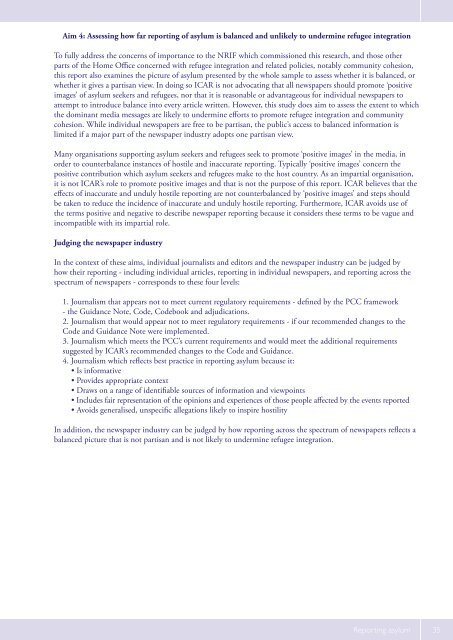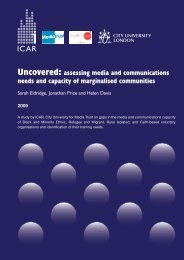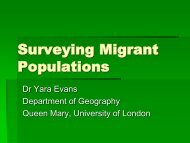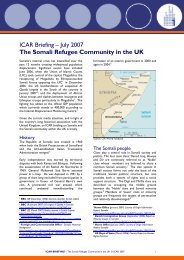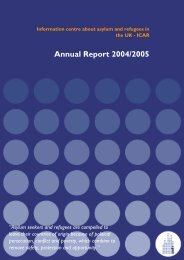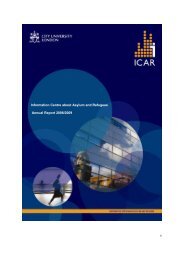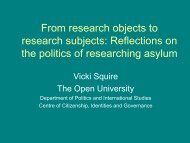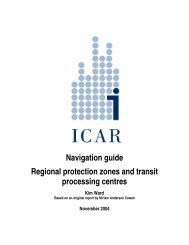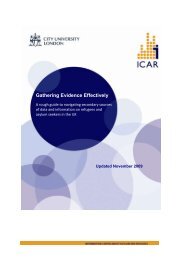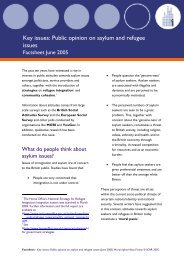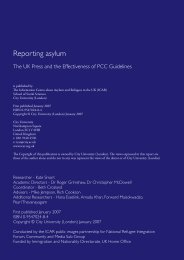Reporting asylum - ICAR
Reporting asylum - ICAR
Reporting asylum - ICAR
Create successful ePaper yourself
Turn your PDF publications into a flip-book with our unique Google optimized e-Paper software.
Aim 4: Assessing how far reporting of <strong>asylum</strong> is balanced and unlikely to undermine refugee integrationTo fully address the concerns of importance to the NRIF which commissioned this research, and those otherparts of the Home Office concerned with refugee integration and related policies, notably community cohesion,this report also examines the picture of <strong>asylum</strong> presented by the whole sample to assess whether it is balanced, orwhether it gives a partisan view. In doing so <strong>ICAR</strong> is not advocating that all newspapers should promote ‘positiveimages’ of <strong>asylum</strong> seekers and refugees, nor that it is reasonable or advantageous for individual newspapers toattempt to introduce balance into every article written. However, this study does aim to assess the extent to whichthe dominant media messages are likely to undermine efforts to promote refugee integration and communitycohesion. While individual newspapers are free to be partisan, the public’s access to balanced information islimited if a major part of the newspaper industry adopts one partisan view.Many organisations supporting <strong>asylum</strong> seekers and refugees seek to promote ‘positive images’ in the media, inorder to counterbalance instances of hostile and inaccurate reporting. Typically ‘positive images’ concern thepositive contribution which <strong>asylum</strong> seekers and refugees make to the host country. As an impartial organisation,it is not <strong>ICAR</strong>’s role to promote positive images and that is not the purpose of this report. <strong>ICAR</strong> believes that theeffects of inaccurate and unduly hostile reporting are not counterbalanced by ‘positive images’ and steps shouldbe taken to reduce the incidence of inaccurate and unduly hostile reporting. Furthermore, <strong>ICAR</strong> avoids use ofthe terms positive and negative to describe newspaper reporting because it considers these terms to be vague andincompatible with its impartial role.Judging the newspaper industryIn the context of these aims, individual journalists and editors and the newspaper industry can be judged byhow their reporting - including individual articles, reporting in individual newspapers, and reporting across thespectrum of newspapers - corresponds to these four levels:1. Journalism that appears not to meet current regulatory requirements - defined by the PCC framework- the Guidance Note, Code, Codebook and adjudications.2. Journalism that would appear not to meet regulatory requirements - if our recommended changes to theCode and Guidance Note were implemented.3. Journalism which meets the PCC’s current requirements and would meet the additional requirementssuggested by <strong>ICAR</strong>’s recommended changes to the Code and Guidance.4. Journalism which reflects best practice in reporting <strong>asylum</strong> because it:• Is informative• Provides appropriate context• Draws on a range of identifiable sources of information and viewpoints• Includes fair representation of the opinions and experiences of those people affected by the events reported• Avoids generalised, unspecific allegations likely to inspire hostilityIn addition, the newspaper industry can be judged by how reporting across the spectrum of newspapers reflects abalanced picture that is not partisan and is not likely to undermine refugee integration.<strong>Reporting</strong> <strong>asylum</strong> 35


